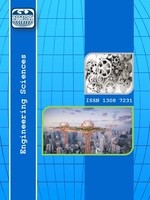INVESTIGATION OF THE EFFECTS OF DETONATIONS NEAR THE BATTALGAZİ CAMPUS OF İNÖNÜ UNIVERSITY, MALATYA, TURKEY ON SOIL SHALLOW-DEPTH
INVESTIGATION OF THE EFFECTS OF DETONATIONS NEAR THE BATTALGAZİ CAMPUS OF İNÖNÜ UNIVERSITY, MALATYA, TURKEY ON SOIL SHALLOW-DEPTH
Geophysic, Resistivity, Shallow Soil Depth Multichannel Vertical Electirical Resistivity, Malatya,
___
- [1] Dongxu, Y., Huanbei, C., Kai-hui, Z., Yongfeng, X., Jinwei, Y., Hanqin, L., and Yu-Ping, Z., (2018). High Temperature Mechanical Properties of Porous Si3N4Prepared via SRBSN. Ceramics International. In Press, Accepted Manuscript—Note to users.
- [2] Araffa, S.A.S., Atya, M.A., Mohamed, A.M.E., Gabala, M., Zaher, M.A., Soliman, M.M., Mesbah, H.S., Massoud, U., and Shaaban, H.M., (2014). Subsurface investigation on Quarter 27 of May 15th city, Cario, Egypt using electrical resistivity tomography and shallow seismic reflaction. NRIAG Journal of Astronomy and Geophysics 3, 170–183.
- [3] Ayyıldız, T., Varol, B., Önal, M., Tekin, E., and Gundoğan, I., (2009). From reef to Pelagic and Evaporate Evalution of Transgressive Successions in the Northwestern Part of Malatya Mesozoic Basin, east Anatolia of Turkey: 27th IAS Meeting of Sedimentologist, 11-116, Alghero, Italy, Medimond, s.r.l..
- [4] Vasantrao, B.M., Bhaskarrao, P.J., Mukund, B.A., Baburao, G.R., and Narayan, P.S., (2017). Comparative Study of Wenner and Schlumberger Electrical Resistivity Method for Groundwater Investigation: a Case Study from Dhule District (M.S.), India, Appl Water Sci (2017) 7:4321–4340.
- [5] Piegari, E., Cataudella, V., Di Maio, R., Milano, L., Nicodemi, M., and Soldovieri, M.G., (2009). Electrical Resistivity Tomography and Statistical Analysis in Landslide Modelling: A Conceptual Approach, Journal of Applied Geophysics 68(2009), 151–158.
- [6] Gözübol, A.M. ve Önal, M., (1986). Çat Barajı Isale Tünelinin Mühendislik Jeolojisi ve Kaya Mekaniği Incelemesi ve Malatya- Çelikhan Alanının Jeolojisi, TÜBİTAK, TBAG-647 Nolu Proje. http://www.google.com/intl/earth/index.html.
- [7] Israil, M. and Pachauri, A.K., (2003). Geophysical Characterization of a Landslide Site in the Himalayan Foothill Region. Journal of Asian Earth Sciences 22(2003), 253–263.
- [8] Jongmans, D. and Garambois, S., (2007). Geophysical Investigation of Landslides: A Review. Bulletin Societe Geologigue de France, 178(2), 101-112.
- [9] Önal, M., (1986). Malatya Baseni, Doğu Kesiminin (Muşardağı Dolayı) Jeolojisi ve Hidrokarbon Olanakları: TPAO Arama Grubu, Rap. No:3863, s:91, Ankara.
- [10] Koral, H. and Önal, M., (2007). Episodic Neotectonic Escape in the Eastern Taurids, SE Turkey: The Malatya Basin: International Geoscience Programmed (UNESCO- IUGS-IGCP).
- [11] Tzou-Shin Ueng, Zih-Fang Wang, Min- Chien Chu, Louis Ge, (2017). Laboratory Tests for Permeability of Sand During Liquefaction, Soil Dynamics and Earthquake Engineering, 100(2017), 249-256.
- Başlangıç: 2009
- Yayıncı: E-Journal of New World Sciences Academy
STANDART OLMAYAN BÜYÜME KOŞULLU DENKLEMLERİN MÜHENDİSLİKTEKİ UYGULAMALARI
Ebubekir AKKOYUNLU, Rabil AYAZOĞLU, Sezgin AKBULUT
Sİ3N4-BN KOMPOZİT TOZ SENTEZİNDE MEKANİK AKTİVASYONUN Sİ3N4 FAZ OLUŞUM KİNETİĞİNE ETKİSİ
Turgay TEHÇİ, Fatih ÇALIŞKAN, Engin KOCAMAN, Zafer TATLI
Ti3SiC2 MAX FAZININ ELEMENTEL TOZ KULLANILARAK SENTEZİ
Ahmet ATASOY, Emre SAKA, Abdullah KOŞAR
KENT İÇİ ULAŞIM İÇİN BULANIK AHP TABANLI VIKOR YÖNTEMİ İLE PROJE SEÇİMİ
EFFECT OF ORIENTATION ANGLES ON VIBRATION PROPERTIES AT CARBON FIBER REINFORCED POLYMERIC COMPOSITES
Muhammet Raci AYDIN, Ömer GÜNDOĞDU, Barbaros KAYA, Gürbüz BAYRAKTAR, Okan Kaan AKSUOĞLU, Osman HOTUNLU
TRIP VE DP ÇELİKLERİNDE DİRENÇ NOKTA KAYNAĞI PARAMETRELERİNİN MEKANİK ÖZELLİKLERE ETKİSİ
Yunus Emre Antika, Zafer Tatlı, Fatih Çalışkan, Turgay Tehçi
THE USE OF SMART PHONES TO ESTIMATE ROAD ROUGHNESS: A CASE STUDY IN TURKEY
